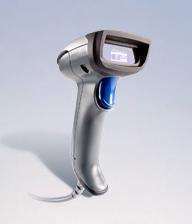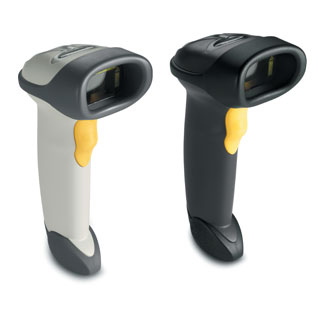How to Choose a Barcode Reader or Barcode Scanner
 A barcode reader or scanner is a device that can read manufacturer’s bar code labels. When the scanner's laser starts picking up a bar code label (UPC for example), it translates the black and white lines of the bar code into the numbers and letters that make up the stock number of the item. It then transmits that stock number to the computer just as if you had typed the number on the keyboard. Obviously typing numbers in all day would be time-consuming and error-prone, which is why barcode readers are considered an indispensable and worthwhile tool for the retail setting.
A barcode reader or scanner is a device that can read manufacturer’s bar code labels. When the scanner's laser starts picking up a bar code label (UPC for example), it translates the black and white lines of the bar code into the numbers and letters that make up the stock number of the item. It then transmits that stock number to the computer just as if you had typed the number on the keyboard. Obviously typing numbers in all day would be time-consuming and error-prone, which is why barcode readers are considered an indispensable and worthwhile tool for the retail setting.
The purpose of a reader/scanner is to save time and increase accuracy while processing transactions. . Barcode readers help you serve customers efficiently and effectively, reduce errors in inventory and pricing, save staff time, and reduce costs.
Types of Barcode Scanners / Barcode Readers
2D imaging scanners
2D imaging scanners are the newest form of barcode readers, and they work by essentially taking a picture of the bar code, and then decoding it. Not only are 2D imaging scanners faster and more accurate than laser scanners, but they offer greater functionality. 2D imaging scanners can read linear--or 1D—bar codes, but can also read 2D bar codes, take digital pictures, shoot video, capture signatures, and scan data. They can read bar codes from any angle, work in bright sunlight, and are better at translating damaged or poor quality bar codes. Recently, 2D imaging scanners have risen to match and exceed the popularity of laser scanners. A big reason for this is that the cost of 2D scanners have come down, enabling the spread of 2D bar codes in various industries (postal services, healthcare, retail, manufacturing, etc.). (Image left - Intermec 2D barcode scanner)
are 2D imaging scanners faster and more accurate than laser scanners, but they offer greater functionality. 2D imaging scanners can read linear--or 1D—bar codes, but can also read 2D bar codes, take digital pictures, shoot video, capture signatures, and scan data. They can read bar codes from any angle, work in bright sunlight, and are better at translating damaged or poor quality bar codes. Recently, 2D imaging scanners have risen to match and exceed the popularity of laser scanners. A big reason for this is that the cost of 2D scanners have come down, enabling the spread of 2D bar codes in various industries (postal services, healthcare, retail, manufacturing, etc.). (Image left - Intermec 2D barcode scanner)
The latest consumer devices such as smartphones and tablets are capable of reading and displaying 2D bar codes. These 2D bar codes, also known as QR codes, have grown in popularity as a marketing tool. Trends for using 2D bar codes for marketing include digital coupons, gift cards, loyalty cards, games and contests. For these marketing tools to work, a retailer must have the ability to scan bar codes from a customer’s smartphone, which means they will need a 2D imaging scanner.
The rise of popularity of 2D imaging scanners has served to make this technology more readily available and affordable for retailers.
Laser Scanners
A laser scanner emits a beam of light on to a bar code, and then translates the reflected light to determine the bar code number. Laser scanners were  specifically created for reading linear, or 1D bar codes, are more effective and reliable than CCD scanners, and can handle uneven surfaces. Laser scanners can read bar codes from greater distances--up to 40+ feet for long range scanners. Some laser scanners can detect when an item is placed in front of them, and automatically turn on and off accordingly—this is known of as “auto-sensing.” With these benefits, laser scanners cost slightly more than CCD scanners, but for many environments are worth the extra money. 1D laser scanners are very popular, and have dominated the market until the recent rise of 2D imaging scanners. (Image, right - Symbol LS2208 Laser Barcode Scanner by Motorola)
specifically created for reading linear, or 1D bar codes, are more effective and reliable than CCD scanners, and can handle uneven surfaces. Laser scanners can read bar codes from greater distances--up to 40+ feet for long range scanners. Some laser scanners can detect when an item is placed in front of them, and automatically turn on and off accordingly—this is known of as “auto-sensing.” With these benefits, laser scanners cost slightly more than CCD scanners, but for many environments are worth the extra money. 1D laser scanners are very popular, and have dominated the market until the recent rise of 2D imaging scanners. (Image, right - Symbol LS2208 Laser Barcode Scanner by Motorola)
Omnidirectional scanners are a type of laser scanner, but send out 15 or 20 beams at once from multiple angles, in order to scan a bar code from any angle. The below-counter scanners you commonly see in supermarkets are an example of omnidirectional scanners, reading packages as they are slid across a glass window. They may also be found in some retail and industrial conveyor type settings.
CCD Barcode Scanners
CCD barcode readers are inexpensive low-end scanners that only read bar codes from a few inches away. CCD readers work by picking up emitted ambient light from a bar code through a tiny row of light sensors. Although a CCD scanner less versatile and less reliable than a laser scanner, it may be a consideration for low-traffic retail settings on a tight budget. They are also usually very durable.
Considerations for Choosing a Barcode Reader
A big consideration when you are purchasing a barcode scanner is the form, or housing type, that the scanner takes, which determines how it will physically be used. Here are the various forms you will want to consider.
Bar Code Symbology
Most barcode scanners can automatically detect different types of bar code symbologies, but it is good idea to know in advance what symbology you will be using and make sure the scanner you choose is compatible.
Connectivity
You will want to ensure that the barcode reader that you choose can connect to your POS system. Scanners may connect through serial ports, keyboard wedges or USB ports on your computer. Find out from your POS software provider what type of connection they support, and also make sure that type of connection is available on your computer.
Customer Volume
A low volume of customers may mean you are less concerned about speed and can get away with low-cost options. High levels of customer traffic probably mean you will want to invest in a laser or imaging scanner. You may also consider an auto-sensing model, or omnidirectional options, depending on your level of customer traffic.
Some other issues about the barcode reader or the environment to think through and discuss with your barcode provider:
Thinking through your expectations, needs, and envionment will help to make sure you choose a barcode scanner that will provide a good return on your investment.
Related Resources:
(Care to add your comments? Please log in or Sign Up - See the Footer Menu - Entry/Sign In, then Register).
{jcomments on}
